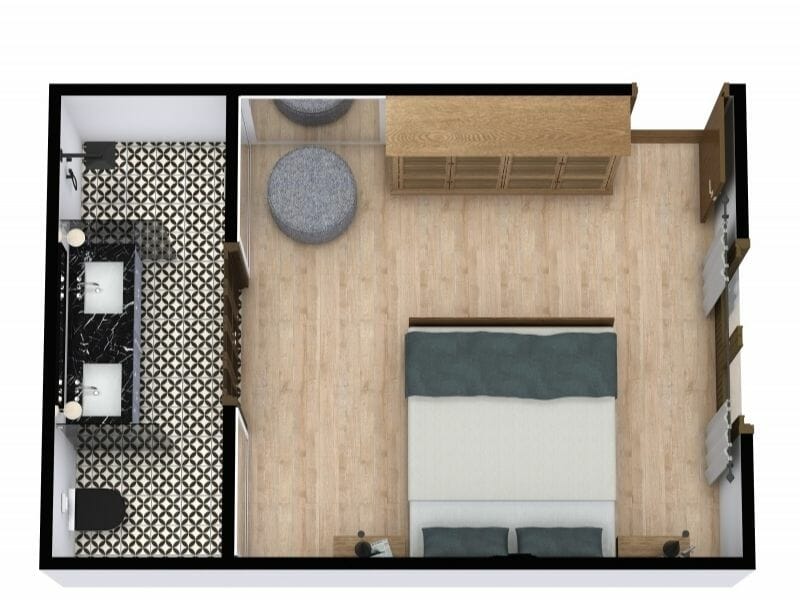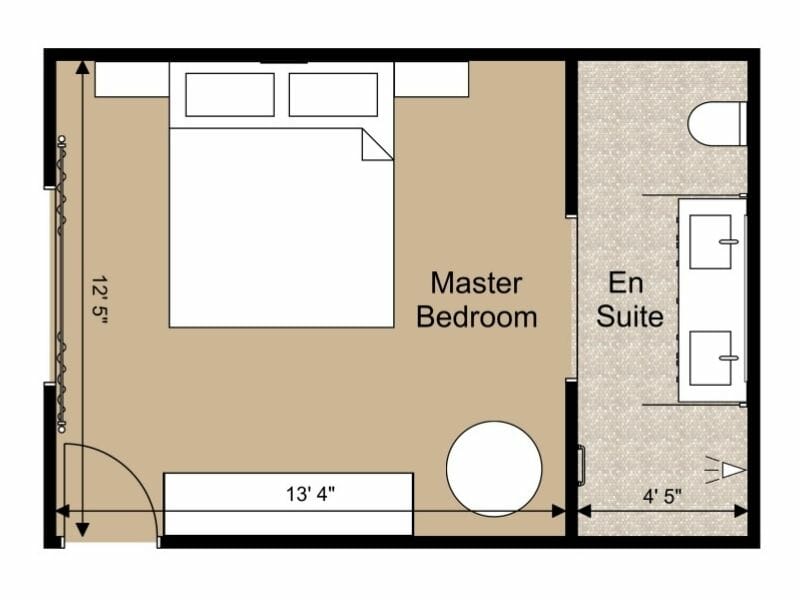Master Bedroom Floor Plan Essentials

A well-designed master bedroom floor plan is crucial for creating a comfortable and functional space. It involves careful consideration of furniture placement, storage solutions, and the flow of movement within the room.
King-Size Bed Placement
The king-size bed is the centerpiece of the master bedroom. It should be positioned to allow for ample walking space around it, ensuring easy access and a sense of spaciousness. A minimum of 2-3 feet of clearance on each side of the bed is recommended. Additionally, consider the placement of the bed relative to windows and doors. Ideally, the headboard should be placed against a wall, not directly in front of a window, to avoid glare and create a more calming atmosphere.
Large Closet or Walk-In Closet
A large closet or walk-in closet is essential for providing ample storage space for clothing, accessories, and other personal belongings. The ideal size for a walk-in closet is at least 8 feet by 8 feet. However, if space is limited, a large closet with double doors and built-in shelves and drawers can still be highly functional.
When planning the closet, consider the following:
- Shelving: Provide ample shelving for folded clothes, shoes, and accessories.
- Hanging Space: Include hanging rods for dresses, suits, and other garments that require hanging.
- Drawers: Incorporate drawers for storing undergarments, socks, and other smaller items.
- Lighting: Ensure adequate lighting within the closet for easy visibility.
Furniture Placement
Beyond the bed and closet, other furniture pieces are essential for creating a functional and stylish master bedroom.
- Dresser: A dresser is needed for storing folded clothes, jewelry, and other items. It should be placed in a location that allows for easy access and is not obstructing the flow of movement within the room.
- Nightstands: Nightstands are essential for holding lamps, books, and other items within reach of the bed. They should be placed on either side of the bed, ensuring enough space for a person to move comfortably between them and the bed.
- Other Furniture: Additional furniture pieces such as a vanity, armchair, or ottoman can be incorporated based on personal preferences and available space.
Window and Door Placement
The placement of windows and doors plays a crucial role in providing natural light and ventilation in the master bedroom.
- Windows: Windows should be strategically placed to allow for natural light and ventilation. Consider the placement of the bed relative to the windows to ensure privacy and avoid glare.
- Doors: The location of the door should facilitate easy access to the bedroom and minimize obstruction of furniture placement.
Room and Furniture Dimensions
Providing detailed dimensions for the room and furniture placement is essential for accurate planning and execution.
- Room Dimensions: Measure the length, width, and height of the master bedroom.
- Furniture Dimensions: Measure the dimensions of the bed, dresser, nightstands, and any other furniture pieces you plan to incorporate.
Furniture Placement and Layout Ideas: Master Bedroom Floor Plan With Furniture

Arranging furniture in a master bedroom is a key step in creating a functional and aesthetically pleasing space. The layout should cater to your needs and preferences, maximizing space and creating a sense of harmony. This section will explore various layout ideas for master bedrooms with different features, such as a king-size bed, two nightstands, a dresser, a seating area, and a walk-in closet.
Master Bedroom Layout with a King-Size Bed, Two Nightstands, a Dresser, and a Seating Area
A well-planned layout can make a master bedroom feel spacious and inviting. Here’s an example:
- Center the King-Size Bed: Place the bed in the center of the room, allowing for easy access from all sides. This creates a focal point and defines the sleeping area.
- Position Nightstands: Place two nightstands flanking the bed, ensuring they are within easy reach. This provides convenient storage for essentials like books, lamps, and glasses of water.
- Add a Dresser: Choose a dresser that complements the bed and nightstands. Place it against a wall, preferably opposite the bed, to create a symmetrical and balanced layout.
- Create a Seating Area: Incorporate a comfortable seating area with an armchair or a small sofa. Position it in a corner or against a wall, creating a distinct space for relaxation and reading.
Master Bedroom Layouts with a Walk-In Closet, Master bedroom floor plan with furniture
A walk-in closet offers ample storage space and enhances the functionality of a master bedroom. The layout of a walk-in closet can vary depending on the size and shape of the space. Here are some popular layouts:
- L-Shaped Layout: This layout is ideal for smaller walk-in closets. It features two walls that meet at a corner, creating an L-shape. This layout allows for efficient use of space and easy access to all areas.
- U-Shaped Layout: This layout is suitable for larger walk-in closets. It utilizes three walls, creating a U-shape. This provides ample storage space and allows for various organizational options.
- Parallel Layout: This layout features two parallel walls with storage units facing each other. It is suitable for long and narrow walk-in closets and offers efficient use of space.
Maximizing Space and Functionality with Furniture Placement
Strategic furniture placement is crucial for maximizing space and functionality in a master bedroom. Here are some tips:
- Utilize Wall Space: Place furniture against walls to free up floor space and create a sense of openness.
- Consider Multi-Functional Furniture: Choose furniture that serves multiple purposes, such as a bed with built-in storage or a dresser with a mirror.
- Use Mirrors: Mirrors can reflect light and make a room appear larger. Place them strategically to enhance the sense of space.
- Keep Traffic Flow Open: Ensure there is enough space to move around comfortably without bumping into furniture.
Creating a Balanced and Visually Appealing Layout
A balanced and visually appealing layout is essential for a harmonious master bedroom. Here are some tips:
- Symmetry: Create a sense of balance by placing furniture symmetrically. For example, place two nightstands flanking the bed.
- Focal Point: Designate a focal point, such as the bed, to draw the eye and create a sense of order.
- Color and Texture: Use color and texture to create visual interest and define different areas.
- Lighting: Use a combination of natural and artificial lighting to create a warm and inviting atmosphere.
Master Bedroom Design Considerations

Once you have a solid floor plan and furniture layout for your master bedroom, it’s time to delve into the design details that will truly make the space your own. These considerations will help you create a haven that is both beautiful and functional.
Flooring Choices
The right flooring can significantly impact the look and feel of your master bedroom. Consider these factors when choosing:
- Comfort: Your master bedroom should be a place of relaxation, so choose flooring that is soft and comfortable underfoot. Carpet is a popular choice for this reason, but wood or laminate flooring can also be comfortable if you choose a thicker, softer option.
- Durability: Your bedroom flooring should be able to withstand daily wear and tear. Hardwood, tile, and laminate are all durable options, but carpet can also be durable if it is properly maintained.
- Style: The flooring you choose should complement the overall style of your bedroom. A classic bedroom might benefit from hardwood floors, while a modern bedroom might look best with tile or laminate.
Lighting Options and Their Moods
Lighting plays a crucial role in setting the mood of your master bedroom. Different types of lighting can evoke a range of feelings, from calm and relaxing to energetic and stimulating.
- Ambient Lighting: This type of lighting provides overall illumination and is typically achieved with ceiling fixtures or lamps. Ambient lighting should be soft and warm to create a relaxing atmosphere. Consider using dimmer switches to adjust the intensity of ambient lighting.
- Task Lighting: If you plan on reading or working in your bedroom, you will need task lighting. This type of lighting provides focused illumination for specific activities. Desk lamps, bedside lamps, and under-cabinet lights are all examples of task lighting.
- Accent Lighting: Accent lighting is used to highlight specific features in your bedroom, such as artwork or architectural details. This type of lighting can add depth and dimension to the space and create a more interesting visual appeal. Use track lighting, sconces, or even strategically placed floor lamps to achieve accent lighting.
Color Palette and its Impact
Color can have a profound impact on the overall feel of your master bedroom. Choose a color palette that reflects your personal style and creates the mood you desire.
- Warm Colors: Warm colors like reds, oranges, and yellows can create a sense of energy and excitement. These colors are well-suited for creating a cozy and inviting atmosphere. However, too much warm color can be overwhelming, so use them sparingly.
- Cool Colors: Cool colors like blues, greens, and purples are often associated with calmness and relaxation. These colors can help to create a serene and tranquil atmosphere. Cool colors can also make a room feel larger and more spacious.
- Neutral Colors: Neutral colors like whites, grays, and beiges are versatile and can be used to create a variety of moods. They can be paired with bolder colors to add pops of personality or used on their own to create a clean and sophisticated look.
Incorporating Personal Touches
The master bedroom should be a reflection of your unique personality and style. Don’t be afraid to incorporate personal touches that make the space feel truly your own.
- Artwork: Hang artwork that you love and that inspires you. Choose pieces that reflect your interests, hobbies, and personal style. Don’t be afraid to mix and match different styles and sizes.
- Decorative Accessories: Add decorative accessories that add personality and interest to your bedroom. Think about throw pillows, blankets, rugs, and sculptures. Choose items that you love and that complement your overall design scheme.
- Plants: Bring the outdoors in with plants. Plants can add life and vibrancy to a space and can also help to improve air quality. Choose plants that are well-suited to the lighting conditions in your bedroom.
A well-designed master bedroom floor plan with furniture allows for optimal flow and functionality. Choosing the right pieces is key, and for a timeless, elegant look, consider broyhill seabrooke bedroom furniture. This collection offers classic designs that complement a variety of styles, ensuring your master bedroom plan is both beautiful and practical.
A well-designed master bedroom floor plan considers not only the placement of furniture but also the flow of the space. While a spacious walk-in closet is a luxury, even smaller bedrooms can benefit from smart storage solutions like slim bathroom storage drawers that can be tucked away in unused corners.
These clever organizers can free up valuable floor space, allowing you to create a calming and functional master bedroom retreat.